Simple Authentic Takoyaki Street Food Recipe
Takoyaki is simple to make when you break it down into its parts: octopus (tako) that is grilled (yaki). The cooking process is a little more complicated than that, as we’ll see in this article.
The trickiest thing in cooking takoyaki is the batter.
Takoyaki is often referred to as “konamono”, which literally just means “flour things”. It falls into the same konamono category as Okonomiyaki and Ikayaki as they’re all prepared with a flour batter (called “Kona” in Japanese).
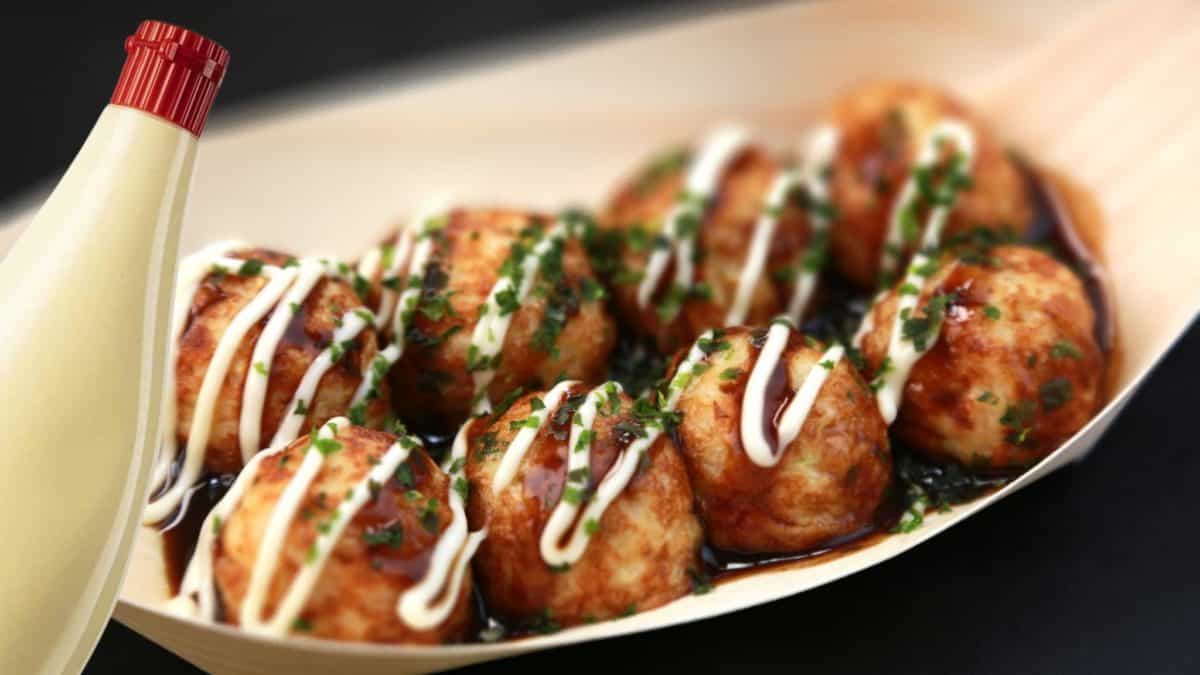

Check out our new cookbook
Bitemybun's family recipes with complete meal planner and recipe guide.
Try it out for free with Kindle Unlimited:
Read for freeIn this post we'll cover:
- 1 How to make takoyaki
- 2 Simple Authentic Takoyaki (octopus balls) recipe
- 3 Takoyaki flour: What is it Made of?
- 4 Tips for cooking takoyaki
- 5 How do you boil octopus for takoyaki?
- 6 What affects the flavor and texture of takoyaki?
- 7 How to serve takoyaki
- 7.1 What do you put on top of takoyaki?
- 7.2 How to serve takoyaki at a street vendor
- 7.3 How to serve takoyaki at a restaurant
- 7.4 How to serve takoyaki at home
- 7.5 Do you eat takoyaki hot or cold?
- 7.6 Do you eat takoyaki in one bite?
- 7.7 How do you eat takoyaki without burning your mouth?
- 7.8 Can I serve takoyaki with rice?
- 8 Conclusion
How to make takoyaki
To make traditional takoyaki, you need 5 ingredients:
- Dashi Flavored Batter – to make dashi flavored batter, add dashi stock cubes dissolved in water to your batter.
- Octopus – you need boiled octopus meat.
- Beni Shoga – red pickled ginger bits give color and flavor to the takoyaki.
- Tenkasu – tempura scraps add that rich umami flavor to the food. They make the takoyaki crispy and creamy.
- Spring Onion – this is the best way to add some color and flavor to the takoyaki. Spring onion is a popular topping.
After those basic ingredients, it’s the toppings that make it more interesting.
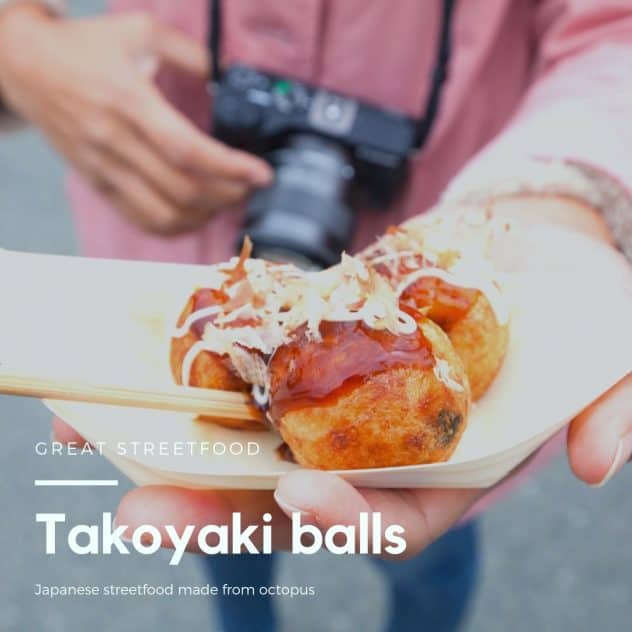
Simple Authentic Takoyaki (octopus balls) recipe
Equipment
- Takoyaki pan or maker
Ingredients
Takoyaki batter
- 10 ounces all-purpose flour
- 3 eggs
- 4 1/4 cups water (1 liter)
- 1/2 tsp salt
- 1/2 tsp kombu dashi stock you can use granules
- 1/2 tsp katsuobushi dashi stock you can use granules
- 2 tsp soy sauce
Filling
- 15 ounces boiled octopus in cubes or you can use any other type of protein as a filling, although it wouldn't really be takoyaki
- 2 green onions sliced
- 1/3 cup tenkasu tempura bits (or use rice krispies)
- 2 tbsp beni shoga (red pickled ginger)
Toppings
- 1 bottle Japanese mayonnaise add to taste
- 1 bottle Takoyaki sauce (you can buy it bottled at a lot of the Asian groceries, you can't miss it with the picture of takoyaki on the front)
- 1 tbsp bonito flakes
- 1 tbsp Aonori or seaweed strips (Aonori is a type of powdered seaweed)
Instructions
- Crack the eggs in a small mixing bowl and add the water as well as the stock granules, then beat the mix manually or with an egg beater. Pour the egg-water-stock granules mixture into the flour, then add salt and mix well (with an egg beater or manually) until you’ve successfully created the batter.
- Turn on the stove and place the takoyaki pan on top of it. Brush the individual half-sphere compartments with oil.
- Two minutes into heating, pour the takoyaki batter into the concave semi-spherical molds. It’s okay if you accidentally make the batter in the molds spill over the brim as you can just gather them later when you’ll flip the batter over for the other side to be cooked.
- Now, add the takoyaki fillings to the batter in the takoyaki pan. First, add 1 or 2 pieces of octopus to each ball, a bit of green onions in each ball, a bit of tempura, and 1 or 2 pieces of beni shoga.
- Two to 3 minutes into cooking the takoyaki, when the bottom of the balls starts to harden, break apart the batter between the balls with your pick or skewers.
- You may now flip it over in order for the other side to cook. Use a takoyaki pick when flipping the ball over in order to not ruin its spherical shape. You must turn the ball 90 degrees when flipping. If you can’t turn the takoyaki easily, it probably needs to cook for a bit longer.
- When you poke the takoyaki to turn it over, some batter flows out and that's okay. Stuff it back in with the pick and add more batter if the ball loses its shape.
- Let it sit in the pan for another 60 seconds before flipping it over. Turn the balls over repeatedly every 45-60 seconds for the next 5 minutes. The takoyaki balls should be easier to turn over once they’ve cooked through because the batter will no longer stick to the pan.
- You will know when the takoyaki is done because it will have a light brown crispy texture on the outside and you can flip them easily in their holes as they no longer stick to the pan. The overall cook time is estimated to be 10 minutes per batch from the time you’ve placed them on the stove to the time you’ll take them out.
- Place the hot takoyaki on a clean plate, then drizzle them with Japanese mayonnaise and takoyaki sauce. Sprinkle them with aonori and bonito flakes as well. Then serve them to your guests.
Video
Takoyaki flour: What is it Made of?
Takoyaki flour is a type of wheat flour combined with cornstarch, baking powder, and salt. It’s characterized by its well-seasoned dashi and soy sauce flavor, which provides takoyaki with its savory batter.
Takoyaki flour is also relatively high in protein, making it an ideal choice for those looking for a nutritious snack option.
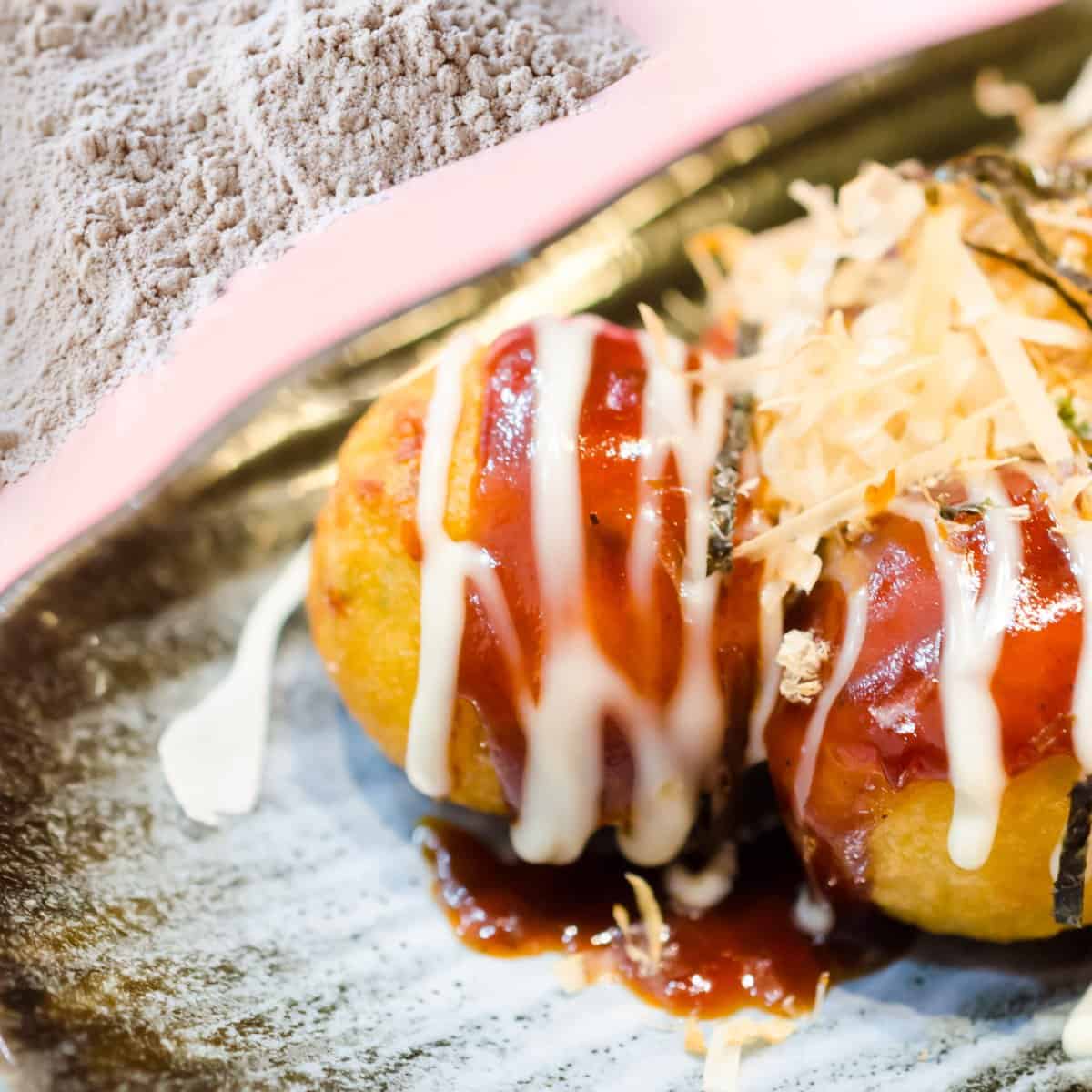
Is takoyaki batter watery?
Takoyaki batter is a smooth and creamy mixture. It needs to be runny enough to easily pour into the molds, but firm enough to turn crispy and hold the ingredients inside. The batter is still a little runny in the center when served.
Takoyaki Flour vs Pancake Flour
Takoyaki flour and pancake flour may seem similar, but they differ in several ways. Here are some of the key differences:
- Takoyaki flour is a special type of flour designed for making takoyaki. It typically includes wheat flour, cornstarch, baking powder, and spices like dashi and soy sauce. Pancake flour, on the other hand, is a type of flour designed for making pancakes and other breakfast foods. It usually includes wheat flour, baking powder, and sugar.
- Takoyaki flour has a higher protein content than pancake flour, which means it creates a slightly chewier result. Pancake flour is designed to create a fluffy, tender texture.
Can I use okonomiyaki flour for takoyaki?
Technically, no. These are two distinct flour mixes. But, the taste and consistency of the batter is fairly similar. Okonomiyaki is made with unbleached wheat flour and takoyaki with all-purpose flour (wheat) and both are flavored with dashi and soy sauce.
Some people even go as far as to recommend you use okonomiyaki flour mix to make the batter for both of these Japanese recipes.
What Brand of Flour Should You Use for takoyaki?
There are many different brands of takoyaki flour available, each with their own unique features and content. It’s important to read the label and description carefully to make sure you are getting the right type of flour for the dish you are preparing. Some popular brands include:
- Glico Takoyaki Flour
- Koda Farms Blue Star Mochiko Sweet Rice Flour
I highly recommend using a takoyaki mix if you don’t like to complicate things. They are all really tasty, and with a bit of experimentation, you’ll get the perfect texture.
Also read: this is where to buy everything you need for takoyaki
Tips for cooking takoyaki
Is takoyaki fried?
Takoyaki is a fried food because the takoyaki pan is a frying pan, even though it has a different shape than most.
The holes are filled with oil so the dough won’t stick to the pan.
The octopus balls might get a bit oily from the deep-frying, so it’s a good idea to keep paper towels nearby. I like to line a bowl with the paper and put each piece onto it, so it can soak up some of the oil before you eat it.
The most important thing is that you use quality octopus when making these, since all the flavor and chewy texture will come from it!
Is takoyaki steamed?
Even though takoyaki balls are fried with oil in a takoyaki pan, the octopus and other ingredients inside are essentially steamed inside the batter. They do not touch the oil or the surface of the pan but are cooked inside the liquid batter.
- When you prepare your ingredients it’s best to cut the beni shoga pickled ginger into fine slices and cut everything into small pieces so that it fits in the batter.
- Beni shoga has a specific pickled taste so it depends on how much you like the flavor. Add 3 pieces if you like it a lot or just 1 for a mild taste.
- You can add 1-3 pieces of octopus per ball depending on your pan size and how small you cut the octopus pieces.
- When you flip the balls over the first few times, some additional batter pours out. So, with picks, press the batter back into the ball. You might have to add more uncooked batter back into the mold to get that perfect round shape. That’s because a lot of batter overflows and you must constantly break up the batter between the balls in the pan or machine.
How do you heat a takoyaki pan?
Allow the pan to heat up gradually for a few minutes. This ensures that the entire pan is evenly heated before adding the batter. Heat up the pan on high heat until it releases a white smoke.
Can you use a Takoyaki Pan on a gas stove?
A gas stove is perfect for heating a takoyaki pan made from cast-iron or aluminum. Make sure the pan is heated evenly and use two burners if necessary.
Set the stove to medium heat. It’s important to find the right balance so that the takoyaki cooks evenly without burning.
To check if the pan is hot enough, you can sprinkle a few drops of water onto the pan’s surface. If the water sizzles and evaporates quickly, it’s an indication that the pan is adequately heated.
Once the pan is heated, add oil to each of the molds. This prevents the takoyaki from sticking to the pan and makes it easier to flip them. Only then pour in the batter.
Can I put a Takoyaki Pan in the oven?
You can put a takoyaki pan in the oven because they’re made to withstand the temperature, but an oven wouldn’t be suitable to cook takoyaki since the heat has to come from underneath to get the batter to form into spheres.
How long should you cook takoyaki?
The ingredients of takoyaki determine the total cooking time needed for the balls. The tenkasu is already cooked and the beni shoga is pickled. That makes two of the four ingredients ready to eat.
So, the cooking time comes down to the other two ingredients:
The dough
The dough needs to be cooked on the outside before adding ingredients. This takes 3 minutes. Then flipped and cooked again for another 3 minutes after the ingredients have been added.
Is takoyaki supposed to be crispy?
The dough on the outside of the takoyaki balls is meant to be crispy. That’s why it’s turned over once every minute for around 5 minutes after the ingredients have been added and the batter on the bottom has solidified.
The octopus
The octopus inside the takoyaki has been pre-boiled, so it is ready to be eaten. It does need to be warmed up by steaming it inside the takoyaki batter that surrounds it.
To get the perfect crispy texture on the outside and the chewy but warm octopus on the inside, this whole process takes 10 minutes from when you first pour the batter into the mold.
The secret to flipping takoyaki is letting any excess batter pour out when you flip the balls the first time. Then, the next time you flip the batter will be perfectly cooked and not overly runny. Once the takoyaki is cooked, it should not stick to the pan at all!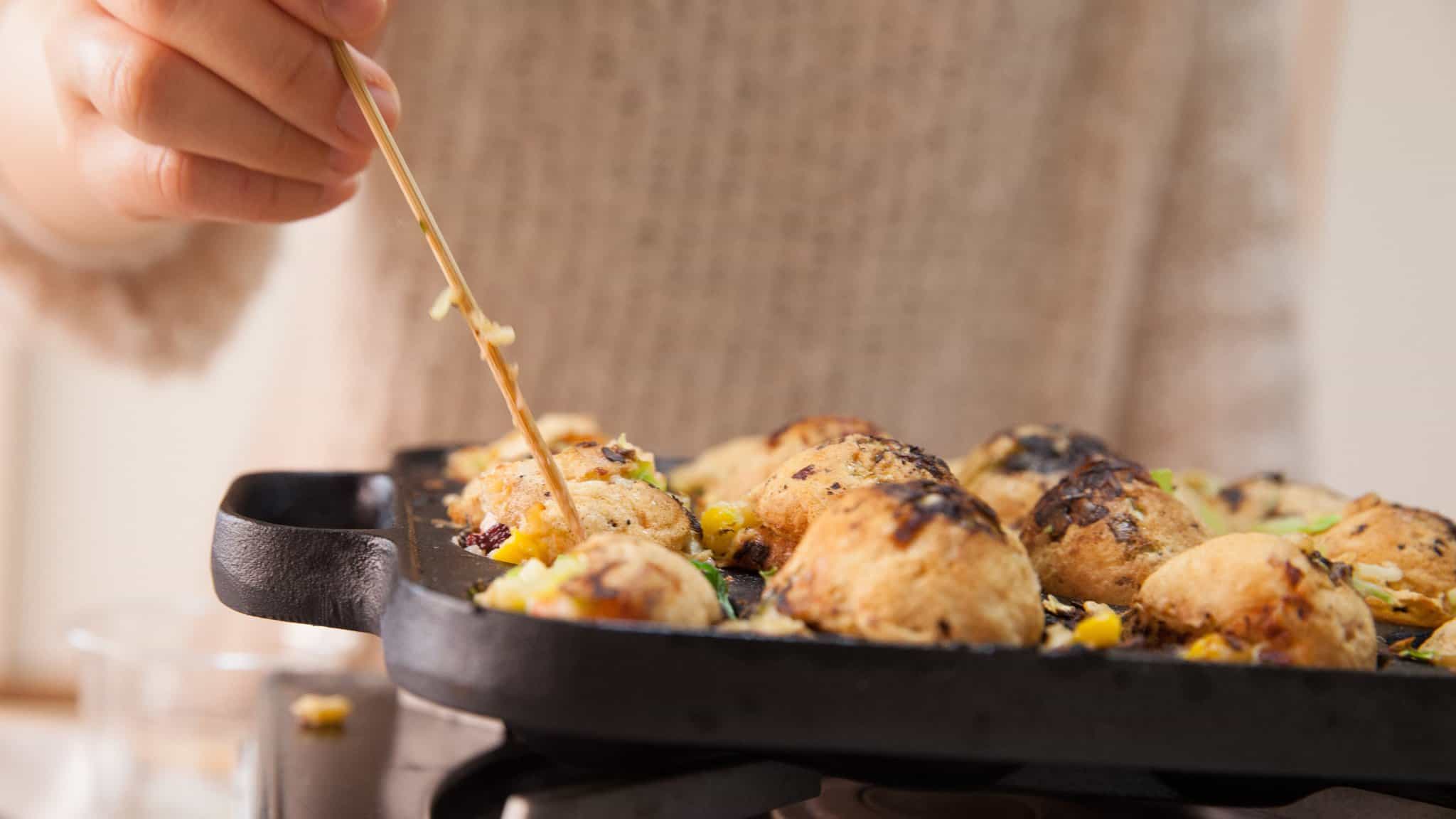
An easy flip starts with the oil and batter, so add oil generously and make sure to fill each mold with lots of batter.
Wait for at least 1-2 minutes or until the bottom half begins to crisp and becomes firm and golden brown, then flip the takoyaki by poking into the surface and rotating your pick to 90 degrees.
Once that side is beginning to firm up, slowly rotate again and keep flipping at 90 degrees until a round takoyaki is formed.
Do not flip the octopus balls too early or else they will crumble!
Does takoyaki flipping need practice?

As the saying goes, “practice makes perfect.” If you are just starting to master the art, you can start practicing 8 or 10 octopus balls each time.
The challenge then is to learn how to gauge the time to start flipping and turning. Once you’ve mastered 8 takoyaki balls, you can increase them to 10 to 14 per batch or more.
Don’t worry though, with a little bit of practice, you’ll get the ball shape just the way it’s supposed to be and then you can flip the hot takoyaki balls without all that batter sticking to the pan. It’s all about timing – don’t flip the balls when the batter is still too runny.
What to use to flip takoyaki
Traditional takoyaki picks are hard, which just means they have a stainless-steel pick and wooden handle. These sturdy picks are long-lasting and great for turning octopus balls because they don’t bend or melt from the heat. Even if you touch the hot pan, the hard pick will stay intact.
How do you know when takoyaki is cooked?
You’ll know when the takoyaki balls are ready when they feel lighter as you poke through them and when they’re crispy on the outside but still a bit gooey on the inside.
How do you boil octopus for takoyaki?
Boiling octopus is quite a meticulous process, and it can all go wrong in an instant, which makes the meat far too chewy and firm.
While we already have an article about how to cook octopus, I want to discuss how to boil the octopus specifically for takoyaki.
If you’re using a fresh octopus, you need to remove the beak with your knife, then pull it out outwards. This should remove most of the organs inside too, but then you can have to clean it out inside to remove all the innards.
If you’re just using cleaned frozen octopus meat, skip the cleaning step.
Now, grab a large pot and fill it with water. Add a couple of pinches of salt. Next, bring the water to a simmer.
Slowly lower the octopus into the water. At this point, the legs begin to curl, and that’s a good sign that your water is at the right temperature.
Let the octopus simmer for 30–45 minutes, depending on the size of your octopus. The larger the animal, the longer it needs to cook. If you’re cooking a small, or baby octopus, don’t exceed the 30 minutes, or it will become too tender and mushy.
Once cooked, remove the octopus from the pot. Takoyaki is best served with tender gooey meat, so I recommend removing the dark red skin while the meat is still hot.
After you’ve removed the skin, you can dice the meat into small 1.5 cm cubes, or about 1/2 inch.
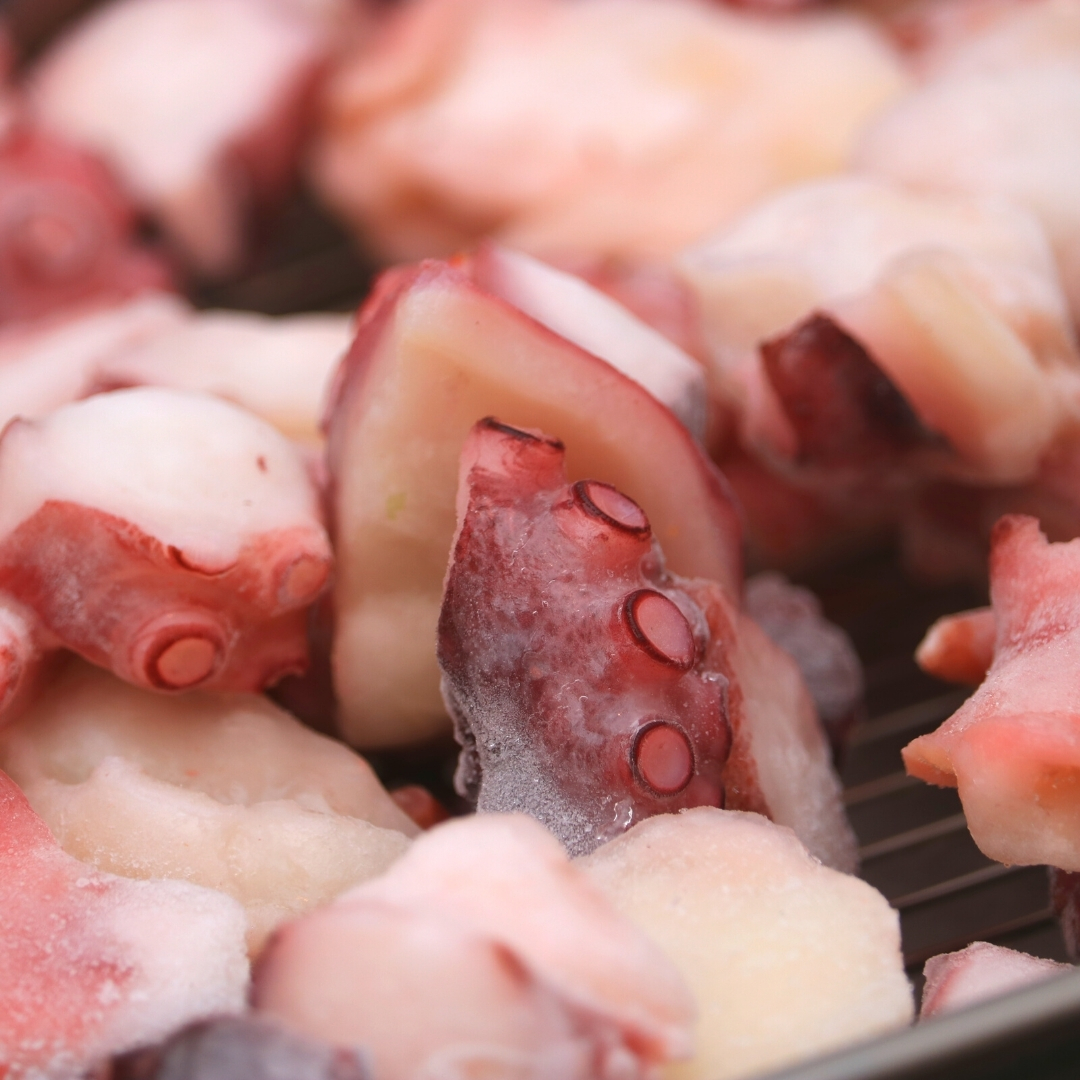
If you cut the octopus into 1/2 inch or smaller you can put two to get that perfect gooey texture and seafood flavor. But, if your pieces are a bit chunkier and larger, 1 piece of octopus per takoyaki is enough. 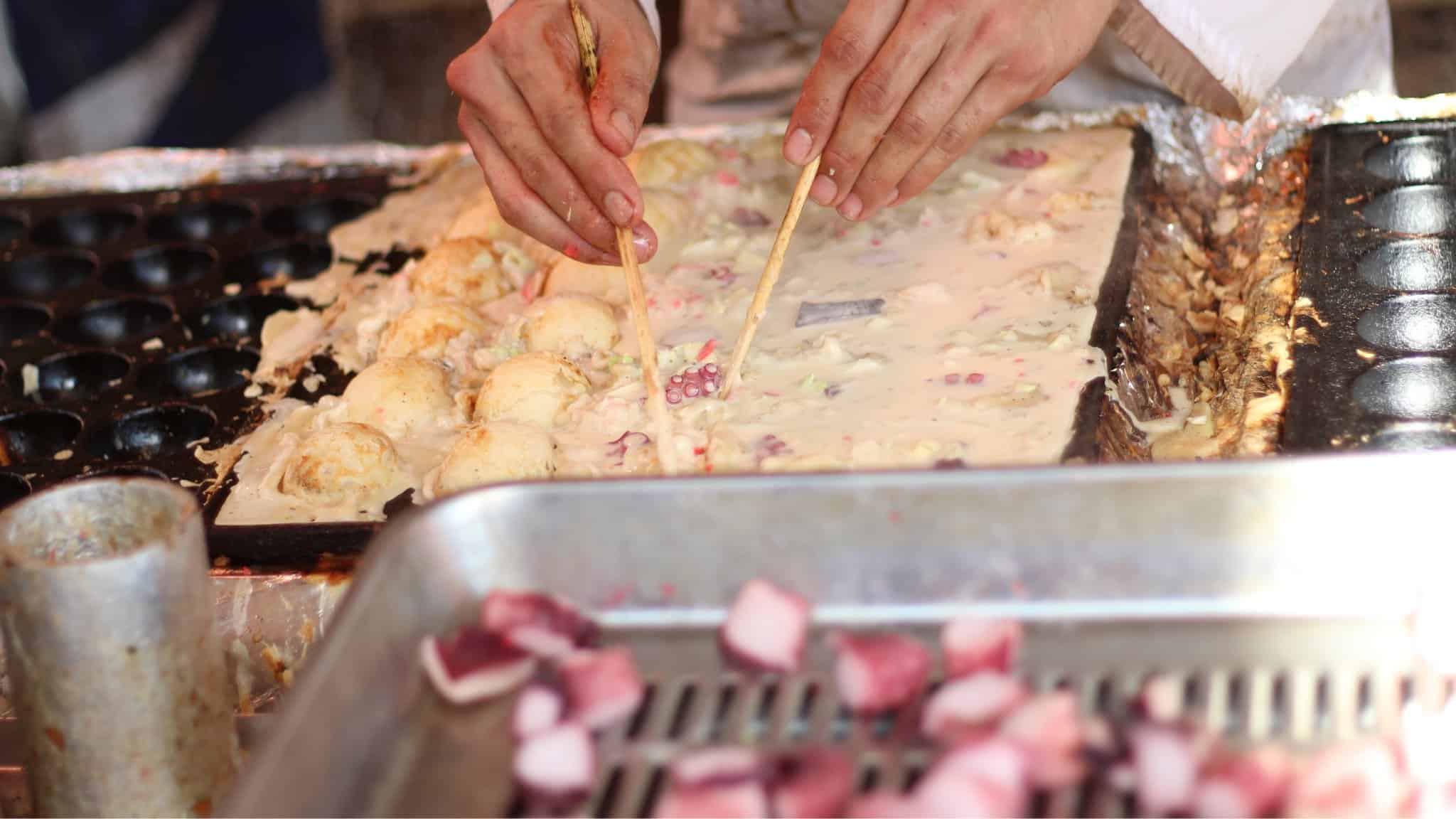
What affects the flavor and texture of takoyaki?
The takoyaki batter is specially made with a mixture that includes flour, egg, and dashi stock, which is already delicious in and on itself.
On top of that, it is also mixed with cooked and diced octopus. Traditionally, some diced scallions or green onions, tenkasu tempura bits, and pickled ginger are added for flavor and texture.
Tenkasu is simply the crunchy bits of deep-fried batter debris from cooking the tempura. Think of it as tempura batter crumbs. It adds crunchiness to every bite of takoyaki.
Add a splash of color to Takoyaki with some red pickled ginger. It gives the octopus balls a refreshing, yet pungent taste when you take a bite.
How to serve takoyaki
You don’t eat takoyaki with chopsticks but with toothpicks. These are small, disposable, and made from bamboo. The balls are covered with toppings like are aonori, katsuobushi, and lots of takoyaki sauce and Japanese mayo.
What do you put on top of takoyaki?
The deep-fried takoyaki on their own isn’t too appetizing without the sauces and dry topping ingredients. The balls are just plain, golden brown straight out of the pan.
The traditional takoyaki is topped with takoyaki sauce and Japanese mayo, drizzled in a colorful zigzag pattern. Then the dry toppings aonori seaweed and katsuobushi (bonito flakes) are sprinkled on top so they stick to the balls.
However, there are many possible toppings, so check out this list:
- takoyaki sauce
- okonomiyaki sauce
- dried bonito flakes
- dried seaweed (aonori)
- Kewpie Japanese mayonnaise
- green onions
- curry powder
- grated cheese
- liquid hon dashi
- dried onion flakes
- soy sauce
- Worcestershire sauce
How to serve takoyaki at a street vendor
At a street vendor, the takoyaki is served very hot right out of the takoyaki pan or takoyaki maker and placed in a styrofoam or cardboard hollow plate. Usually, they serve 6 or 8 octopus balls per serving.
The vendor adds the toppings and gives you a small skewer or toothpick to use as utensils. Bamboo sticks are most common, and you can get multiple ones if you are sharing your food with others.
How to serve takoyaki at a restaurant
There are some really cool restaurants where you can make your own takoyaki on a machine and it’s kind of like making your own yakiniku barbecue, making the octopus balls and adding your own toppings.
If you’re being served the takoyaki that a chef prepares, they bring them out on a larger plate. Then, each person transfers their portion of takoyaki onto their plate.
The waiter will also bring out the toppings. First, you pour the takoyaki sauce and drizzle some mayonnaise. Next, you sprinkle a bit of katsuobushi, dried seaweed, and the spring onion.
How to serve takoyaki at home
Once fried, take the takoyaki octopus balls and place them on a plate and add the sauces, bonito flakes, and green onions. Your kids and family will probably start eating the balls right away, but you can batch cook them, so you constantly have hot ones to serve.
Do you eat takoyaki hot or cold?
Takoyaki is delicious whether served hot or cold, and can be eaten both ways depending on personal preferences. An overwhelming majority of people eat the snack while it’s burning hot as soon as it comes out of the takoyaki pan. In restaurants, traditionally, they would be served hot as well.
Since the favorite takoyaki toppings like bonito flakes, takoyaki sauce, and Japanese Kewpie mayonnaise are poured onto the hot octopus balls, it’s best to eat them hot or warm to avoid all the toppings melting together.
It can make the crunchy balls very moist and overly soft.
Do you eat takoyaki in one bite?
After waiting a few minutes, you can eat the takoyaki right out of the plate on the street, even while standing or walking. Once the takoyaki has cooled slightly, you can eat the sauce-doused octopus balls in one bite.
How do you eat takoyaki without burning your mouth?
After around 2 minutes, it should have cooled down enough to consume it. If you prefer piping hot octopus balls, poke a hole into the side of it and allow some of the steam to escape. Then, put the skewer on your lip to test the temperature.
You can also try a small section to test before eating the whole thing to prevent it from burning your mouth or tongue.

Can I serve takoyaki with rice?
If you love rice, you can obviously pair your takoyaki with a side of rice. Nobody is going to stop you from trying new combinations with takoyaki. But generally, takoyaki is not served with rice. People eat it as is with takoyaki sauce and toppings as a snack.
But, did you know there is a tasty dish which is a combination of onigiri and takoyaki? It’s called Takoyaki onigiri and it is made with bonito-flavored rice like onigiri but stuffed with takoyaki fillings like diced octopus, some batter, and sauce.
It’s different from the takoyaki because this is served cold like traditional onigiri. So, if you lack the patience to wait for hot takoyaki balls to cool down, this chilled snack might be a good option to try.
Conclusion
You see, there’s nothing mysterious or difficult about making authentic Japanese takoyaki. You can do it yourself in your own kitchen.
If you want some more flavor variations check out these best takoyaki recipes here
Check out our new cookbook
Bitemybun's family recipes with complete meal planner and recipe guide.
Try it out for free with Kindle Unlimited:
Read for freeJoost Nusselder, the founder of Bite My Bun is a content marketer, dad and loves trying out new food with Japanese food at the heart of his passion, and together with his team he's been creating in-depth blog articles since 2016 to help loyal readers with recipes and cooking tips.
